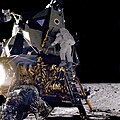月球門戶
 | |
 | |
| 太空站資訊 | |
|---|---|
| 成員數量 | 最多4人(計畫) |
| 發射日期 | 2027年(計畫) |
| 發射載具 | 獵鷹重型運載火箭 SLS Block 1B運載火箭 |
| 發射台 | 甘迺迪太空中心39號發射台
|
| 任務狀態 | 研製中 |
| 加壓體積 | ≥125 m3(4,400 cu ft) (計畫) |
| 遠地點 | 70,000 km(43,000 mi) |
| 近地點 | 3,000 km(1,900 mi) |
| 軌道傾角 | 極地近直線暈軌道 (NRHO) |
| 軌道週期 | ≈7天 |
| 組態圖 | |
 截至2022年11月16日的艙段組態圖 | |
月球門戶(英語:Lunar Gateway)太空站,簡稱門戶太空站,是計畫於2020年代在月球近直線暈軌道上組裝的太空站。作為阿提米絲計畫的一部分,門戶太空站旨在充當太空人的通訊中心、科學實驗室和居住艙。與國際太空站類似,月球門戶是一個多國合作專案:參與者包括美國國家航空暨太空總署(NASA)、歐洲太空總署(ESA)、日本宇宙航空研究開發機關(JAXA)、加拿大太空局(CSA)和阿聯酋穆罕默德·本·拉希德太空中心(MBRSC)。門戶計畫將成為首個位於低地球軌道以外的太空站。[1][2]
預計將在門戶太空站上研究的科學學科包括行星科學、天體物理學、地球觀測、太陽物理學、基礎空間生物學以及人類健康和表現。[3]截至2024年4月,門戶太空站最初的居住和推進模組的建設正在進行中。[4][5][6]由包括美國國家航空暨太空總署在內的14個太空機關組成的國際空間探索協調小組(ISECG)認為,在將人類活動擴充到月球、火星以及太陽系更深處的過程中,門戶太空站系統將是至關重要的。[7]
門戶太空站預計將在2024年後在阿提米絲計畫中發揮重要作用。美國太空總署2025財年預算中為該專案撥款8.177億美元。[8]雖然該專案由美國太空總署牽頭,但門戶太空站與加拿大太空局、歐洲太空總署、日本宇宙航空研究開發機關和商業夥伴合作開發、維護和使用。它將作為無人和載人探索月球南極的中轉站,也是美國太空總署前往火星的「深空運輸」概念中建議的中轉節點。[9][10][11]


名稱
[編輯]該太空站原名為深空門戶(Deep Space Gateway,簡稱DSG),在美國太空總署2018年提交的2019年美國聯邦預算提案中更名為月球軌道平台門戶(Lunar Orbital Platform-Gateway,簡稱LOP-G)。[12][13]2019年2月15日,NASA預算簽署成為法律時,[14]國會已承諾撥款4.5億美元用於初步研究。[14][15]
2019年11月,美國太空總署公布了太空站現在的名稱和標誌,標誌靈感來自象徵美國邊疆的聖路易斯大拱門。[16]
歷史
[編輯]深太空門戶太空站初是NASA已取消的小行星重新導向任務的一部分[17]。2017年9月27日,美俄太空當局發表了關於雙方合作的非正式聯合聲明。[18][19]地月間飛行獲得的資訊和經驗有助於未來月球軌道範圍以外進行的深太空探索。深太空門戶初期將執行在月球附近的暈軌道(NRHO)[20]。計畫開始實施後,太空站的各個組件將由太空發射系統以獵戶座太空船酬載的形式在任務EM-2至EM-8發射。據俄羅斯太空總署稱,他們也可能使用質子-M和安加拉-A5M重型火箭發射酬載或人員。
太空站的能源與推進系統(英語:Power and Propulsion Element,簡稱PPE)品質8至9噸,利用太陽能發電提供50千瓦[21]的電力為離子推進器供電。離子推進器也可由化學推進器輔助[22]。
研究
[編輯]美國國家航空暨太空總署於2017年11月1日委託了5項為期四個月的研究來藉助私人公司之力尋找開發能源與推進系統的經濟方法,這些研究的預算合計240萬美元。波音、洛克希德·馬丁公司、軌道科學公司、內華達山脈公司和Space Systems / Loral公司承擔了該研究[23]。這是繼2016年下一代空間技術探索夥伴關係第二階段(英語:Next Space Technologies for Exploration Partnerships-2,簡稱NextSTEP-2)商業公司研製居住模組之後的又一次計畫。這樣的方式可以用於深太空門戶,也可以用其他商業專案,所以深太空門戶可能也會在NextSTEP方式下開發其他組件[24]。
組件
[編輯]



為了支援計畫於2028年進行的首次載人太空站任務(阿提米絲4號),門戶太空站將以僅由兩個模組組成的最小太空站開始:能源與推進模組(PPE)以及居住與後勤模組(HALO)。PPE和HALO都將在地球上組裝,並於2027年一起搭載獵鷹重型火箭發射升空。[25][26]預計它們將在9到10個月後到達月球軌道。[27]I-Hab模組由ESA和JAXA共同研發,將作為阿提米絲4號載人獵戶座任務的聯合酬載,搭載在SLS Block1B上發射。[28]所有模組將採用國際對接系統標準對接。[29]
計畫模組
[編輯]- 能源與推進模組(英語:Power and Propulsion Element, PPE)用於為太空站和離子推進器發電,與HALO模組一同發射。
- 居住與後勤模組(英語:Habitation and Logistics Outpost, HALO)為太空站提供長期居住的條件,提供一個獵戶座太空船的對介面,與PPE一同在2027年由獵鷹重型發射。
- 歐洲燃料補給、基礎設施與通訊服務系統模組(英語:European System Providing Refueling, Infrastructure and Telecommunications, ESPRIT)為太空站提供燃料、通訊和一個貨運飛船對介面。其第一部分Lunar Link隨HALO一同發射,第二部分Lunar View將於2029年阿提米絲5號任務發射。
- 月球國際居住模組(英語:Lunar International Habitation, Lunar I-HAB)是一個附加居住艙,將於2028年阿提米絲4號任務發射。
- 加拿大臂3(英語:Canadarm3)是一對機器人遙控機械臂,一大一小,與太空梭加拿大臂和國際太空站加拿大臂2大致相似。
- 乘員科學氣閘艙(英語:Crew and Science Airlock Module)用於支援艙外活動,並為深空運輸太空飛行器提供對介面,將於2031年由阿提米絲6號任務發射。
參見
[編輯]參考文獻
[編輯]- ^ FY 2022: NASA Budget Request (PDF). NASA. 28 May 2021 [1 June 2021].
- ^ Jackson, Shanessa. Competition Seeks University Concepts for Gateway and Deep Space Exploration Capabilities. nasa.gov. NASA. 11 September 2018 [19 September 2018]. (原始內容存檔於17 June 2019).
- ^ Mahoney, Erin. NASA Seeks Ideas for Scientific Activities Near the Moon. nasa.gov. NASA. 24 August 2018 [19 September 2018]. (原始內容存檔於9 June 2019).
- ^ Hambleton, Kathryn. Deep Space Gateway to Open OpportunitiesArtemis for Distant Destinations. nasa.gov. NASA. 28 March 2017 [April 5, 2017]. (原始內容存檔於27 September 2017).
- ^ РОСКОСМОС – NASA СОВМЕСТНЫЕ ИССЛЕДОВАНИЯ ДАЛЬНЕГО КОСМОСА (ROSCOSMOS – NASA JOINT RESEARCH OF FAR COSMOS). [September 29, 2017]. (原始內容存檔於10 September 2019) (俄語).
- ^ Weitering, Hanneke. NASA and Russia Partner Up for Crewed Deep-Space Missions. Space.com. 27 September 2017 [5 November 2017]. (原始內容存檔於10 September 2019).
- ^ NASA. Gateway Memorandum for the Record (PDF). nasa.gov. NASA. 2 May 2018 [19 September 2018]. (原始內容存檔 (PDF)於25 July 2019).
- ^ FY 2025 Budget Estimates (PDF).
- ^ Gebhardt, Chris. NASA finally sets goals, missions for SLS – eyes multi-step plan to Mars. nasaspaceflight.com. NASASpaceflight. 6 April 2017 [19 September 2018]. (原始內容存檔於21 August 2017).
- ^ Hambleton, Kathryn. Deep Space Gateway to Open OpportunitiesArtemis for Distant Destinations. nasa.gov. NASA. 28 March 2017 [April 5, 2017]. (原始內容存檔於27 September 2017).
- ^ Gatens, Robyn; Crusan, Jason. Cislunar Habitation and Environmental Control and Life Support System (PDF). nasa.gov. NASA. [March 31, 2017].
- ^ Davis, Jason. Some snark (and details!) about NASA's proposed lunar space station. The Planetary Society. February 26, 2018 [February 26, 2018]. (原始內容存檔於February 26, 2018).
- ^ Yuhas, Alan. Trump's Nasa budget: flying 'Jetson cars' and a return to the Moon. The Guardian. 2018-02-12 [2018-02-25]. (原始內容存檔於18 July 2019). 參數
|newspaper=與模板{{cite web}}不匹配(建議改用{{cite news}}或|website=) (幫助) - ^ 14.0 14.1 Foust, Jeff. Final fiscal year 2019 budget bill secures $21.5 billion for NASA. Space News. February 17, 2019 [April 8, 2023].
- ^ NASA just got its best budget in a decade. planetary.org. [27 February 2019]. (原始內容存檔於16 February 2019).
- ^ Pearlman, Robert Z. NASA Reveals New Gateway Logo for Artemis Lunar Orbit Way Station. space.com. September 18, 2019 [28 June 2020]. (原始內容存檔於28 June 2020).
- ^ NASA Seeks Information on Developing Deep Space Gateway Module (頁面存檔備份,存於網際網路檔案館). Jeff Foust, Space. 29 July 2017.
- ^ "РОСКОСМОС - NASA. СОВМЕСТНЫЕ ИССЛЕДОВАНИЯ ДАЛЬНЕГО КОСМОСА (ROSCOSMOS - NASA. JOINT RESEARCH OF FAR COSMOS)". [2017-09-29]. (原始內容存檔於2019-09-10).
- ^ Weitering, Hanneke. NASA and Russia Partner Up for Crewed Deep-Space Missions. Space.com. 2017-09-27 [2017-11-05]. (原始內容存檔於2019-09-10).
- ^ Godwin, Curt. NASA's human spaceflight plans come into focus with announcement of Deep Space Gateway. Spaceflight Insider. 2017-04-01 [2017-04-02]. (原始內容存檔於2017-07-31).
- ^ NASA issues study contracts for Deep Space Gateway element. Jeff Foust, Space News. 3 November 2017.
- ^ Chris Gebhardt. NASA finally sets goals, missions for SLS – eyes multi-step plan to Mars. [2017-04-09]. (原始內容存檔於2017-08-21).
- ^ Jimi Russell. NASA Selects Studies for Gateway Power and Propulsion Element. [2017-11-02]. (原始內容存檔於2018-01-12).
- ^ Erin Mahoney. NextSTEP Partners Develop Ground Prototypes to Expand our Knowledge of Deep Space Habitats. NASA. [2017-11-06]. (原始內容存檔於2017-04-10).
- ^ "Artemis Programs: NASA Should Document and Communicate Plans to Address Gateway's Mass Risk". GAO. 31 July 2024. Retrieved 31 July 2024.
- ^ NASA, Gateway Overview. NASA. 3 May 2024 [8 May 2024].
- ^ Foust, Jeff. NASA refines plans for launching Gateway and other Artemis elements. spacenews.com. SpaceNews. 14 May 2020 [18 May 2020]. (原始內容存檔於16 May 2020).
- ^ NASA FY 2022 Budget Estimates (PDF): PDF page 97, in-text page DEXP-67.
Delivery of I-Hab to the Gateway will be via the SLS Block 1B launch vehicle with Orion providing orbital insertion and docking.
- ^ Patel, Neel V. NASA Unveils Deep Space Gateway and Transport Architectures. Inverse. 2017-04-04 [2024-05-08] (英語).
外部連結
[編輯]- Deep Space Gateway to Open Opportunities for Distant Destinations(頁面存檔備份,存於網際網路檔案館)- NASA Journey to Mars
- First human outpost near the Moon(頁面存檔備份,存於網際網路檔案館)-RussianSpace Webpage about the Deep Space Gateway





